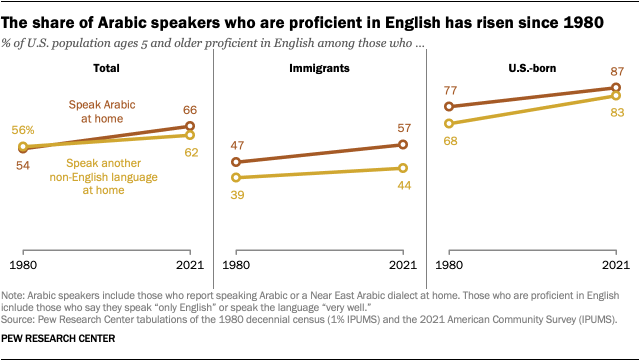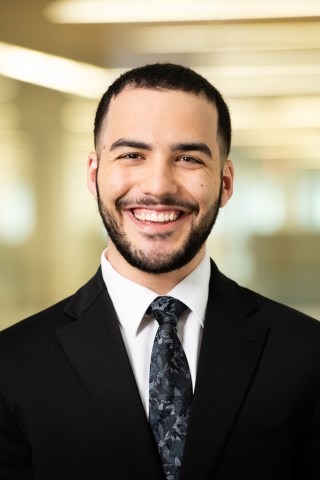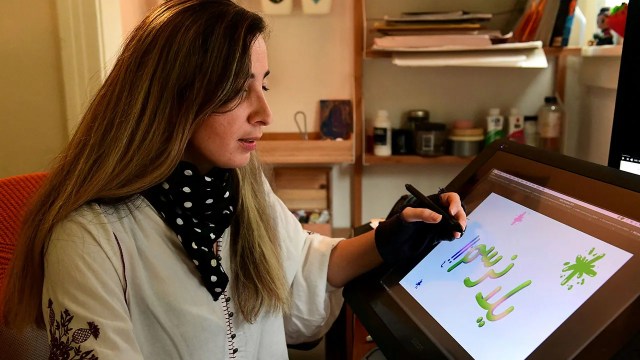
Arabic has become a much more widely spoken language in the United States in recent decades. The number of people ages 5 and older who speak Arabic at home in the U.S. rose from 215,000 in 1980 to 1.4 million in 2021, making it the nation’s seventh-most common non-English language spoken at home. Arabic speakers represent several nationalities and include both immigrants and those born in the U.S.
Here are five facts about Arabic speakers in the U.S., based on a Pew Research Center analysis of Census Bureau data.
Pew Research Center conducted this analysis to examine the number and share of Arabic speakers and speakers of other non-English languages in the United States among individuals ages 5 and older. It uses microdata from 1% samples of the 1980, 1990 and 2000 decennial censuses and the U.S. Census Bureau’s 2010 and 2021 American Community Surveys accessed through Integrated Public Use Microdata Series (IPUMS) from the University of Minnesota.
Because Arabic is one of the official languages of more than 20 countries, mostly in the Middle East or North Africa, Arabic speakers in the U.S. represent a large, multi-national group. Arabic speakers are defined as those who report speaking Arabic or a Near East Arabic dialect (such as Syriac, Aramaic, Chaldean or Syrian). In 2021, about 95% of Arabic speakers report speaking Arabic at home, while the other 5% report speaking a Near East Arabic dialect. The Census Bureau only collects language data for those who are ages 5 and older.
Another approach to analyzing the share of the U.S. population with an Arab background could use the Census Bureau’s data on self-reported Arab ancestry. However, because many people with Arab ancestry tend to report an ancestry related to their nationality or ethnic group (e.g., Iraqi or Egyptian) instead of their Arab ancestry, the ancestry variable identifies a much smaller group of the U.S. population as Arab than this analysis of Arabic speakers.
All displayed numbers are rounded. Shares and percent changes are calculated using unrounded numbers.
The number of Arabic speakers in the U.S. has increased dramatically since 1980, surpassing the numbers of people who speak other languages that were once more common among U.S. immigrants. For example, while the numbers of people in the U.S. who speak German or Italian at home have declined by 36% and 68%, respectively, from 1980 to 2021, the number speaking Arabic at home has grown by 581% during that time. Growth in the number of Arabic speakers has easily outpaced growth among speakers of several other languages from the Middle East, such as Persian/Farsi, Hebrew and Turkish.
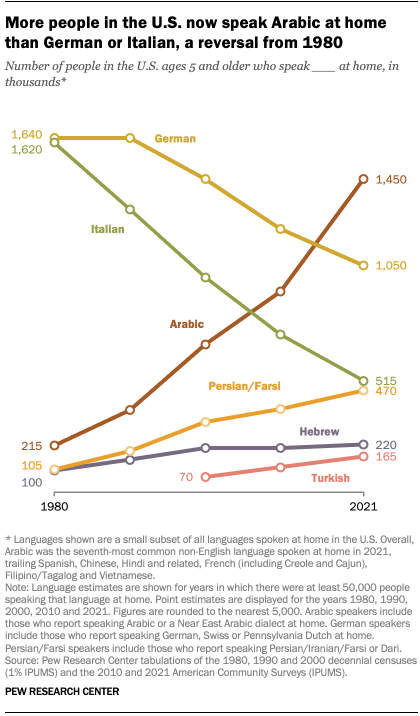
The share of the U.S. population speaking Arabic at home has also grown immensely, though it remains small. In 1980, those who spoke Arabic at home accounted for only 0.10% of the U.S. population ages 5 and older. By 2021, this share had grown to 0.46%. In other words, about 46 of every 10,000 people in the U.S. ages 5 and older speak Arabic at home.
Immigrants account for around two-thirds of those who speak Arabic at home in the U.S. However, the reverse is true when looking only at the youngest Arabic speakers: Among those ages 5 to 17, about two-thirds are U.S. born.
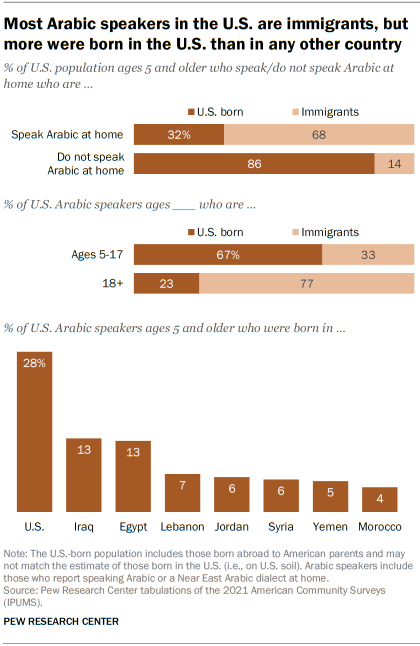
The number of Arabic speakers who were born in the U.S. is larger than the number born in any single foreign country. While 28% of all Arabic speakers were born in the U.S., just 13% were born in Iraq and 13% were born in Egypt, the next-most common origins of U.S. Arabic speakers.
About half of all Arabic speakers in the U.S. (53%) live in just five states. California has the highest share of any state at 17%, followed by Michigan (14%), Texas (8%), New York (7%) and New Jersey (6%).
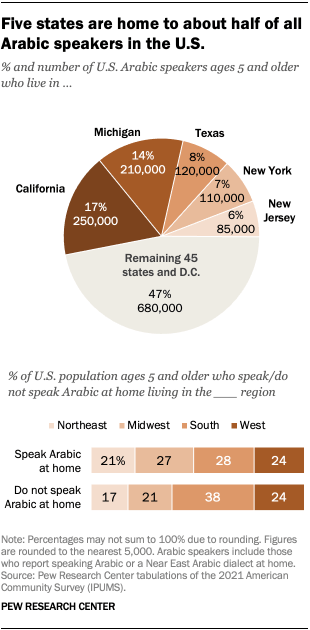
Every region of the U.S. is home to a substantial share of the Arabic-speaking population. The South (28%) and Midwest (27%) have the highest shares, while the Northeast (21%) has the lowest share. The population that does not speak Arabic at home, by comparison, has a different geographic distribution. Non-Arabic speakers are more likely than Arabic speakers to live in the South (38% vs. 28%) and less likely to live in the Midwest (21% vs. 27%).
The Detroit region has the most Arabic speakers of any U.S. metro area. About 190,000 Arabic speakers live in the Detroit-Warren-Dearborn metro area in Michigan. They represent about 13% of all Arabic speakers in the U.S. and 91% of those in Michigan.
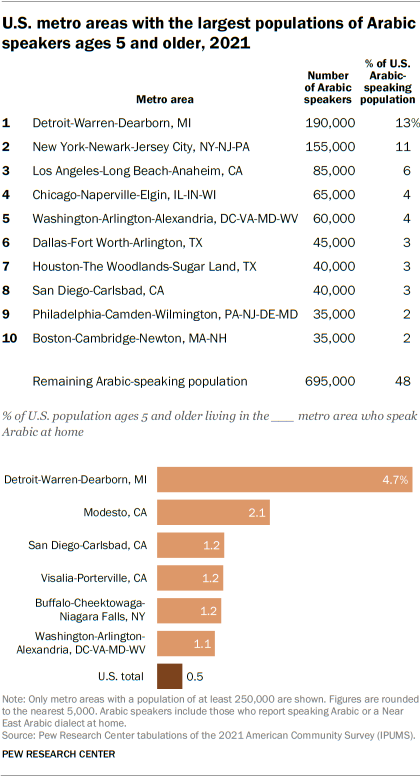
The next-most common metro areas for Arabic speakers are New York-Newark-Jersey City (155,000) and Los Angeles-Long Beach-Anaheim (85,000). Overall, about half of the U.S. Arabic-speaking population lives in the top 10 metro areas.
The Detroit metro area also has the largest concentration of Arabic speakers, with 4.7% of the population ages 5 and older speaking Arabic at home. Only five other metro areas with more than 250,000 people have Arabic-speaking populations that exceed 1.0% of the total population. Three of those are in California: the Modesto, San Diego-Carlsbad and Visalia-Porterville metro areas.
About two-thirds of Arabic speakers (66%) are proficient in English, up from 54% in 1980. By comparison, English proficiency has risen less among people who speak another non-English language at home, from 56% in 1980 to 62% in 2021.
Notably, both immigrant and U.S.-born Arabic speakers have contributed to the increase in English proficiency among Arabic speakers. From 1980 to 2021, the share of immigrant Arabic speakers who are proficient in English rose from 47% to 57%, while for U.S.-born Arabic speakers it rose from 77% to 87%.
